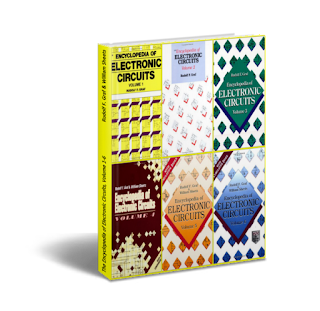
ENCYCLOPEDIA OF ELECTRONIC 1000 CIRCUITS PDF SERIES
Practical resistors have a series inductance and a small parallel capacitance these specifications can be important in high-frequency applications. VZR power resistor 1.5 kΩ 12 W, manufactured in 1963 in the Soviet Union Nonideal properties

However even placing 750 V across a 100 MΩ resistor continuously would only result in a power dissipation of less than 6 mW, making the nominal 1⁄ 4 watt rating meaningless. For instance, among 1⁄ 4 watt resistors (a very common sort of leaded resistor) one is listed with a resistance of 100 MΩ and a maximum rated voltage of 750 V.

Resistors may be specified with higher rated dissipation than is experienced in service to account for poor air circulation, high altitude, or high operating temperature.Īll resistors have a maximum voltage rating this may limit the power dissipation for higher resistance values. There are flameproof resistors that will not produce flames with any overload of any duration. Excessive power dissipation may raise the temperature of the resistor to a point where it can burn the circuit board or adjacent components, or even cause a fire. If the average power dissipated by a resistor is more than its power rating, damage to the resistor may occur, permanently altering its resistance this is distinct from the reversible change in resistance due to its temperature coefficient when it warms. Power resistors are physically larger and may not use the preferred values, color codes, and external packages described below. Power resistors are required to dissipate substantial amounts of power and are typically used in power supplies, power conversion circuits, and power amplifiers this designation is loosely applied to resistors with power ratings of 1 watt or greater. The nominal value of the resistance falls within the manufacturing tolerance, indicated on the component.Īn aluminium-encased power resistor rated for dissipation of 50 W when mounted on a heat-sink The electrical function of a resistor is specified by its resistance: common commercial resistors are manufactured over a range of more than nine orders of magnitude. Resistors are also implemented within integrated circuits. Practical resistors as discrete components can be composed of various compounds and forms. Resistors are common elements of electrical networks and electronic circuits and are ubiquitous in electronic equipment. Variable resistors can be used to adjust circuit elements (such as a volume control or a lamp dimmer), or as sensing devices for heat, light, humidity, force, or chemical activity. High-power resistors that can dissipate many watts of electrical power as heat may be used as part of motor controls, in power distribution systems, or as test loads for generators.įixed resistors have resistances that only change slightly with temperature, time or operating voltage.


In electronic circuits, resistors are used to reduce current flow, adjust signal levels, to divide voltages, bias active elements, and terminate transmission lines, among other uses. Various resistor types of different shapes and sizesĪ resistor is a passive two-terminal electrical component that implements electrical resistance as a circuit element.


 0 kommentar(er)
0 kommentar(er)
